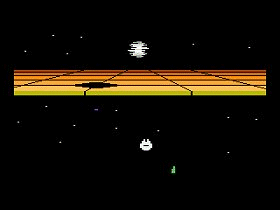 The Game: Presumably, you play the part of Lando Calrissian in this game, which seems to follow the events in the latter half of the film Return of the Jedi. Piloting the Millennium Falcon, you dart around the perimeter defense shield of the Empire’s new Death Star, which is still being constructed before your very eyes. You must eliminate a certain number of TIE Interceptors before a hole opens in the shield, allowing you to get close enough to start blowing pieces out of the Death Star itself. But an automatic defense system won’t take long to track you down and eliminate you, so you have to work fast. The sooner you can hit the Death Star power core, the better. And when you accomplish that, you have to worry about dodging the flaming debris of the huge space station… (Parker Brothers, 1983)
The Game: Presumably, you play the part of Lando Calrissian in this game, which seems to follow the events in the latter half of the film Return of the Jedi. Piloting the Millennium Falcon, you dart around the perimeter defense shield of the Empire’s new Death Star, which is still being constructed before your very eyes. You must eliminate a certain number of TIE Interceptors before a hole opens in the shield, allowing you to get close enough to start blowing pieces out of the Death Star itself. But an automatic defense system won’t take long to track you down and eliminate you, so you have to work fast. The sooner you can hit the Death Star power core, the better. And when you accomplish that, you have to worry about dodging the flaming debris of the huge space station… (Parker Brothers, 1983)
 Memories: Possibly the best game Parker Brothers released out of its series of four Star Wars titles, Death Star Battle had some truly great graphics considering which machine they were squeezed out of. The vaguely 3-D grid of the Death Star’s defense perimeter would constantly shift colors, and it was actually very pretty. The game play itself was no slouch either – one out of five times is about how often I manage to evade all the Death Star debris without getting creamed.
Memories: Possibly the best game Parker Brothers released out of its series of four Star Wars titles, Death Star Battle had some truly great graphics considering which machine they were squeezed out of. The vaguely 3-D grid of the Death Star’s defense perimeter would constantly shift colors, and it was actually very pretty. The game play itself was no slouch either – one out of five times is about how often I manage to evade all the Death Star debris without getting creamed.

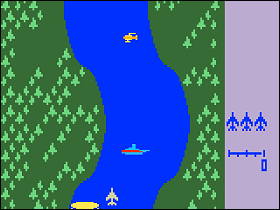 The Game: You’re piloting a fighter jet on a canyon run through enemy territory. You can’t fly outside the canyon walls, so stay over the river and blast everything in sight. Well, almost everything – flying your plane on top of “FUEL” buoys instead of shooting them puts a little bit of gas in the tank, and if you run out of fuel, you might as well just swallow the next enemy bullet, because you’re goin’ down. (Activision, 1983)
The Game: You’re piloting a fighter jet on a canyon run through enemy territory. You can’t fly outside the canyon walls, so stay over the river and blast everything in sight. Well, almost everything – flying your plane on top of “FUEL” buoys instead of shooting them puts a little bit of gas in the tank, and if you run out of fuel, you might as well just swallow the next enemy bullet, because you’re goin’ down. (Activision, 1983)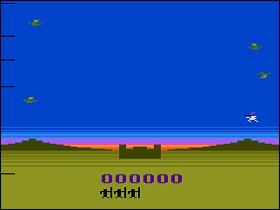 The Game: In Sir Lancelot, players assume the role of the legendary knight atop his flying steed (who knew that the Arthurian mythos could be mixed with the Greek legend of Pegasus?), battling a sky seething with dragons. Killing all the dragons on the screen will advance Lancelot to another level featuring a “boss” dragon and a damsel awaiting rescue.
The Game: In Sir Lancelot, players assume the role of the legendary knight atop his flying steed (who knew that the Arthurian mythos could be mixed with the Greek legend of Pegasus?), battling a sky seething with dragons. Killing all the dragons on the screen will advance Lancelot to another level featuring a “boss” dragon and a damsel awaiting rescue.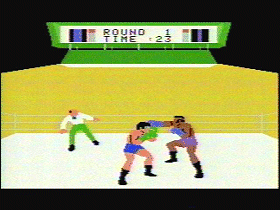 The Game: Spin up “Eye Of The Tiger” on your turntable, power up your Colecovision, and get ready to go ten rounds with Clubber Lang. If you think you’re tough enough to take on a digital Mr. T, take a swing at helping Rocky Balboa reign victorious once more. Just be ready to taste the mat along the way too. (Coleco, 1983)
The Game: Spin up “Eye Of The Tiger” on your turntable, power up your Colecovision, and get ready to go ten rounds with Clubber Lang. If you think you’re tough enough to take on a digital Mr. T, take a swing at helping Rocky Balboa reign victorious once more. Just be ready to taste the mat along the way too. (Coleco, 1983)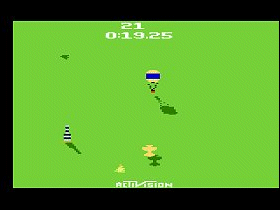

 The Game: Aliens are closing in on your planetary base, and apparently you’re the only one on call to fend them off. Shields protect your ground-hugging mobile cannon, but they tend to be eroded away quickly by both incoming enemy fire and your own shots from the ground. If enemy ships infiltrate your protective bunker, you can find yourself in a very close-quarters firefight. When you eliminate a wave of alien ships, the next wave moves in to attack. (Spectravideo, 1983)
The Game: Aliens are closing in on your planetary base, and apparently you’re the only one on call to fend them off. Shields protect your ground-hugging mobile cannon, but they tend to be eroded away quickly by both incoming enemy fire and your own shots from the ground. If enemy ships infiltrate your protective bunker, you can find yourself in a very close-quarters firefight. When you eliminate a wave of alien ships, the next wave moves in to attack. (Spectravideo, 1983)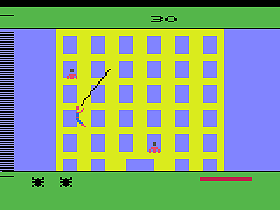 The Game: The Green Goblin and his henchmen are terrorizing the city once more, and it’s up to Spider-Man to restore order. But the odds are against him: he can only attach his web to the surface of the building, naturally, but the Goblin’s underlings are ready and eager to cut Spidey’s web should it be planted near them. Worse yet, the difficult-to-navigate high voltage tower at the top of the building is riddled with the Goblin’s bombs, and even if Spidey can defuse them, there’s a Super Bomb waiting for him at the top of the building – and he can only put it out of commission after dealing with the Green Goblin personally. (Parker Brothers, 1983)
The Game: The Green Goblin and his henchmen are terrorizing the city once more, and it’s up to Spider-Man to restore order. But the odds are against him: he can only attach his web to the surface of the building, naturally, but the Goblin’s underlings are ready and eager to cut Spidey’s web should it be planted near them. Worse yet, the difficult-to-navigate high voltage tower at the top of the building is riddled with the Goblin’s bombs, and even if Spidey can defuse them, there’s a Super Bomb waiting for him at the top of the building – and he can only put it out of commission after dealing with the Green Goblin personally. (Parker Brothers, 1983)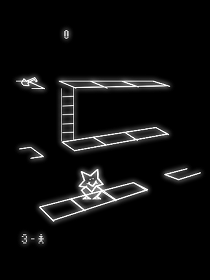 The Game: Poor Spike – his girlfriend Molly has been snatched by a beastly enemy, and it’s up to Spike to rescue her (after, of course, declaring “Darnit!”). Spike must climb his way up several ever-moving platforms. He can change the position of the ladders he uses to climb up these platforms, but it’s not as easy as simply reaching the top: to advance to the next level, Spike has to grab a key. Beastly henchmen scoot along the platforms to bump Spike off to his death, but Spike can kick them away momentarily. (GCE, 1983)
The Game: Poor Spike – his girlfriend Molly has been snatched by a beastly enemy, and it’s up to Spike to rescue her (after, of course, declaring “Darnit!”). Spike must climb his way up several ever-moving platforms. He can change the position of the ladders he uses to climb up these platforms, but it’s not as easy as simply reaching the top: to advance to the next level, Spike has to grab a key. Beastly henchmen scoot along the platforms to bump Spike off to his death, but Spike can kick them away momentarily. (GCE, 1983) The Game: Welcome to the bridge. Your mission is to travel from sector to sector, eliminating Klingon incursions into Federation space without getting your ship and crew destroyed. Friendly starbases offer aid and allow you to make resupply stops so you can keep up the good fight – and you do have to keep a careful eye on your phaser, shield and warp power… (Sega, 1983)
The Game: Welcome to the bridge. Your mission is to travel from sector to sector, eliminating Klingon incursions into Federation space without getting your ship and crew destroyed. Friendly starbases offer aid and allow you to make resupply stops so you can keep up the good fight – and you do have to keep a careful eye on your phaser, shield and warp power… (Sega, 1983)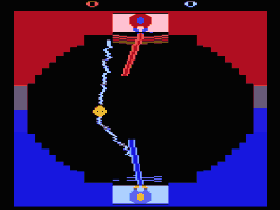 The Game: You weren’t born with a lightsaber in your hands. Even a Jedi Knight must practice his skills. Two Jedi are safely tucked away behind deflector shields, while an automatic seeker ball roams the center of a large chamber. You can use the Force to influence the seeker to attack your opponent, and you can deflect the seeker’s laser bolts when your opponent does the same to you. And every once in a while, the seeker goes into berzerk mode, firing multiple bolts at both contestants, pummeling their shields until one or both are defenseless. (Parker Brothers, 1983)
The Game: You weren’t born with a lightsaber in your hands. Even a Jedi Knight must practice his skills. Two Jedi are safely tucked away behind deflector shields, while an automatic seeker ball roams the center of a large chamber. You can use the Force to influence the seeker to attack your opponent, and you can deflect the seeker’s laser bolts when your opponent does the same to you. And every once in a while, the seeker goes into berzerk mode, firing multiple bolts at both contestants, pummeling their shields until one or both are defenseless. (Parker Brothers, 1983) The Game: The alien abductors are back. Their henchbeings are back. And fortunately for the hapless humans on the planet’s surface, you’re back too, in a fully armed warship with a belly full of smart bombs. But the aliens have brought new and unusual reinforcements, and now the ultimate X-factor is seen visibly floating in the night sky – a stargate which could deposit your space fighter anywhere, delivering you to safety…or a rendezvous with a swarm of aliens. (Atari, 1983)
The Game: The alien abductors are back. Their henchbeings are back. And fortunately for the hapless humans on the planet’s surface, you’re back too, in a fully armed warship with a belly full of smart bombs. But the aliens have brought new and unusual reinforcements, and now the ultimate X-factor is seen visibly floating in the night sky – a stargate which could deposit your space fighter anywhere, delivering you to safety…or a rendezvous with a swarm of aliens. (Atari, 1983)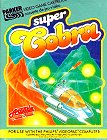 The Game: You’re piloting a heavily armed helicopter straight into a heap o’ trouble. Ground and air defenses have been mounted in this enemy installation to stop you at any costs. Missiles, anti-aircraft turrets, and even other vehicles will do anything to knock you out of the sky – and given the chunky terrain, the odds are in favor of the house. Your only saving grace is that you’re armed to the teeth. But, as you may have guessed by now, even that may not be enough to save you. (Supposedly, according to Konami, Super Cobra was their sequel to the minor arcade hit Scramble.) (Parker Brothers, 1983)
The Game: You’re piloting a heavily armed helicopter straight into a heap o’ trouble. Ground and air defenses have been mounted in this enemy installation to stop you at any costs. Missiles, anti-aircraft turrets, and even other vehicles will do anything to knock you out of the sky – and given the chunky terrain, the odds are in favor of the house. Your only saving grace is that you’re armed to the teeth. But, as you may have guessed by now, even that may not be enough to save you. (Supposedly, according to Konami, Super Cobra was their sequel to the minor arcade hit Scramble.) (Parker Brothers, 1983)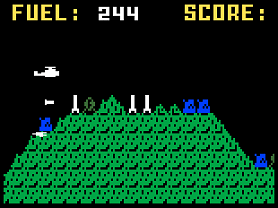 The Game: You’re piloting a heavily armed helicopter straight into a heap o’ trouble. Ground and air defenses have been mounted in this enemy installation to stop you at any costs. Missiles, anti-aircraft turrets, and even other vehicles will See the videodo anything to knock you out of the sky – and given the chunky terrain, the odds are in favor of the house. Your only saving grace is that you’re armed to the teeth. But, as you may have guessed by now, even that may not be enough to save you. (Parker Brothers, 1983)
The Game: You’re piloting a heavily armed helicopter straight into a heap o’ trouble. Ground and air defenses have been mounted in this enemy installation to stop you at any costs. Missiles, anti-aircraft turrets, and even other vehicles will See the videodo anything to knock you out of the sky – and given the chunky terrain, the odds are in favor of the house. Your only saving grace is that you’re armed to the teeth. But, as you may have guessed by now, even that may not be enough to save you. (Parker Brothers, 1983) The Game: Commanding a fleet of ships, you use their combined firepower to wipe out an onslaught of alien ships (which, perhaps not at all surprisingly, are firing back at you). It only takes one hit to lose one of your own fleet, and when your fleet is completely wiped out, the game is over. Until then, do as much damage to the enemy armada as you can. (Sega, 1983)
The Game: Commanding a fleet of ships, you use their combined firepower to wipe out an onslaught of alien ships (which, perhaps not at all surprisingly, are firing back at you). It only takes one hit to lose one of your own fleet, and when your fleet is completely wiped out, the game is over. Until then, do as much damage to the enemy armada as you can. (Sega, 1983)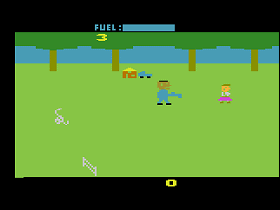 The Game: You’re Leatherface, the notorious killer, and your job is pretty simple: track down those meddling teenagers (a prerequisite for every horror flick) and slice ‘n’ dice them with your chainsaw. Simple enough, right? It would be if not for obstacles that block your path (some of which you can also dispose of with your chainsaw), and the fact that – get this – these kids scream and run away from you. The nerve! But you can sever that nerve, and all the others, with your chainsaw…at least until it runs out of fuel. (Wizard, 1983)
The Game: You’re Leatherface, the notorious killer, and your job is pretty simple: track down those meddling teenagers (a prerequisite for every horror flick) and slice ‘n’ dice them with your chainsaw. Simple enough, right? It would be if not for obstacles that block your path (some of which you can also dispose of with your chainsaw), and the fact that – get this – these kids scream and run away from you. The nerve! But you can sever that nerve, and all the others, with your chainsaw…at least until it runs out of fuel. (Wizard, 1983) The Game: Players control a space fighter on patrol as alien attack fleets gather in deep space. Always keeping a wary eye on his ship’s fuel and laser temperature, would-be space heroes must blow away every alien ship on the screen before collecting the reward – namely, the privelege of blowing away another wave of alien attackers. (Sierra On-Liine, 1983)
The Game: Players control a space fighter on patrol as alien attack fleets gather in deep space. Always keeping a wary eye on his ship’s fuel and laser temperature, would-be space heroes must blow away every alien ship on the screen before collecting the reward – namely, the privelege of blowing away another wave of alien attackers. (Sierra On-Liine, 1983)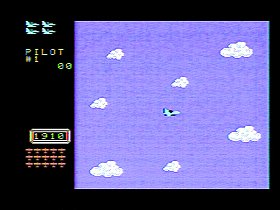 The Game: You’re flying solo through the fourth dimension! In what must be the least subtle time-traveling intervention since the last time there was a time travel episode on Star Trek: Voyager, you’re blasting your way through
The Game: You’re flying solo through the fourth dimension! In what must be the least subtle time-traveling intervention since the last time there was a time travel episode on Star Trek: Voyager, you’re blasting your way through 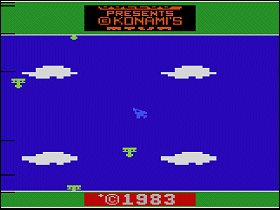 The Game: You’re flying solo through the fourth dimension! In what must be the least subtle time-traveling intervention since the last time there was a time travel episode on Star Trek: Voyager, you’re blasting your way through dozens of aircraft from 1940 through 1982. From WWII-era prop planes, to Vietnam-era helicopters, to 1982, where you confront jet fighters with the same maneuverability as your plane, you’re in for quite a wild ride. Rescue parachutists and complete the level by destroying “boss” craft such as heavy planes and dirigibles. (Coleco, 1983)
The Game: You’re flying solo through the fourth dimension! In what must be the least subtle time-traveling intervention since the last time there was a time travel episode on Star Trek: Voyager, you’re blasting your way through dozens of aircraft from 1940 through 1982. From WWII-era prop planes, to Vietnam-era helicopters, to 1982, where you confront jet fighters with the same maneuverability as your plane, you’re in for quite a wild ride. Rescue parachutists and complete the level by destroying “boss” craft such as heavy planes and dirigibles. (Coleco, 1983)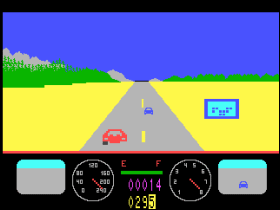 The Game: The Videopac puts you in the driver’s seat for a cross-country race. Avoid other cars and obstacles and stay on the road; hitting too many oncoming vehicles causes you to forfeit the race. (Philips, 1983)
The Game: The Videopac puts you in the driver’s seat for a cross-country race. Avoid other cars and obstacles and stay on the road; hitting too many oncoming vehicles causes you to forfeit the race. (Philips, 1983)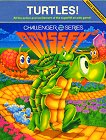 The Game: As the mama turtle, you trundle around a simple maze, pursued by nasty bugs which are lethal to the touch. You can drop bombs in their path, which will reduce their speed (and this device really does beg all sorts of biological double-entendres, doesn’t it?). Your mission is to visit the isolated cul-de-sacs in the maze – which in itself can lead to your turtle getting trapped – to retrieve your eggs and take them to safe houses dotted around the maze. If you visit the wrong place at the wrong time, you’ll wind up with not an egg, but a new bug hot on your heels. Getting all your turtle eggs to safety takes you to the next level, and eventually everything winds up moving so fast, you haven’t got a chance. (North American Philips [under license from Stern], 1983)
The Game: As the mama turtle, you trundle around a simple maze, pursued by nasty bugs which are lethal to the touch. You can drop bombs in their path, which will reduce their speed (and this device really does beg all sorts of biological double-entendres, doesn’t it?). Your mission is to visit the isolated cul-de-sacs in the maze – which in itself can lead to your turtle getting trapped – to retrieve your eggs and take them to safe houses dotted around the maze. If you visit the wrong place at the wrong time, you’ll wind up with not an egg, but a new bug hot on your heels. Getting all your turtle eggs to safety takes you to the next level, and eventually everything winds up moving so fast, you haven’t got a chance. (North American Philips [under license from Stern], 1983) The Game: As an intrepid, pith-helmeted explorer, you’re exploring King Tut’s catacombs, which are populated by a variety of killer bugs, birds, and other nasties. You’re capable of firing left and right, but not vertically – so any oncoming threats from above or below must be outrun or avoided. Warp portals will instantly whisk you away to other parts of the maze (though this doesn’t necessarily mean safer). Gathering all of the treasures and keys will allow you to open the vault at the end of each level…which leads to the next, and even more difficult level. (Parker Brothers, 1983)
The Game: As an intrepid, pith-helmeted explorer, you’re exploring King Tut’s catacombs, which are populated by a variety of killer bugs, birds, and other nasties. You’re capable of firing left and right, but not vertically – so any oncoming threats from above or below must be outrun or avoided. Warp portals will instantly whisk you away to other parts of the maze (though this doesn’t necessarily mean safer). Gathering all of the treasures and keys will allow you to open the vault at the end of each level…which leads to the next, and even more difficult level. (Parker Brothers, 1983)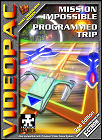 The Game: On an enclosed grid, you control a robotic drone whose job is to collect certain items on the grid and deflect enemies away from those items. If you can plant obstacles – which deflect your enemies with 90-degree left or right turns – that lock your pursuers into an inescapable infinite loop, all the better…but more will come. (Ectron, 1983 [unreleased prototype] / custom copies released in 2006)
The Game: On an enclosed grid, you control a robotic drone whose job is to collect certain items on the grid and deflect enemies away from those items. If you can plant obstacles – which deflect your enemies with 90-degree left or right turns – that lock your pursuers into an inescapable infinite loop, all the better…but more will come. (Ectron, 1983 [unreleased prototype] / custom copies released in 2006) The Game: Piloting a series of solo space fighters, you’re humanity’s last hope against a fleet of gigantic, triangular wedge-shaped battle cruisers bearing down on Earth. Launching from a staging area equipped with a hyperspace gate to fling your fighters into the void at top speed, you must strafe these cruisers in your fighter, bombing and blasting their gun emplacements, engines, and an assortment of weak spots on their ship. The enemy cruisers also have defensive fighters that they’ll launch to keep you from getting the job done, and of course the cruisers themselves are bristling with enormous laser cannons. Hitting all of the guns, engines and other “soft targets” on a cruiser will destroy it, giving you a momentary reprieve until the next cruiser arrives. If you run out of ships or fail to stop the enemy, they’ll wipe out your planet – game over, indeed. (Activision, 1982)
The Game: Piloting a series of solo space fighters, you’re humanity’s last hope against a fleet of gigantic, triangular wedge-shaped battle cruisers bearing down on Earth. Launching from a staging area equipped with a hyperspace gate to fling your fighters into the void at top speed, you must strafe these cruisers in your fighter, bombing and blasting their gun emplacements, engines, and an assortment of weak spots on their ship. The enemy cruisers also have defensive fighters that they’ll launch to keep you from getting the job done, and of course the cruisers themselves are bristling with enormous laser cannons. Hitting all of the guns, engines and other “soft targets” on a cruiser will destroy it, giving you a momentary reprieve until the next cruiser arrives. If you run out of ships or fail to stop the enemy, they’ll wipe out your planet – game over, indeed. (Activision, 1982)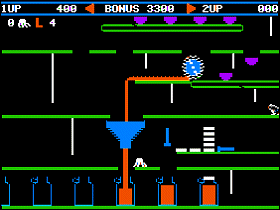 The Game: You control a spider, wandering though a factory that makes cider, and to survive this trip you better be a good hider, for the spider can’t survive with any apples that might collide ‘er. The spider can become a rider on conveyor belts, but she can also fall off if the spider tries to jump over something wider than she can navigate. The goal is to help your spider reach home despite all the perils that would divide ‘er. (Sierra On-Line, 1983)
The Game: You control a spider, wandering though a factory that makes cider, and to survive this trip you better be a good hider, for the spider can’t survive with any apples that might collide ‘er. The spider can become a rider on conveyor belts, but she can also fall off if the spider tries to jump over something wider than she can navigate. The goal is to help your spider reach home despite all the perils that would divide ‘er. (Sierra On-Line, 1983)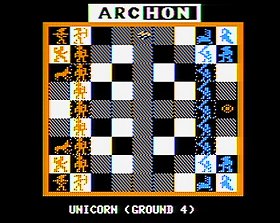 The Game: What if chess pieces were living creatures, each with its own unique abilities? And what if, every time to pieces met on the board, they had to fight amongst themselves to occupy the square in question? That’s Archon in a nutshell. (Electronic Arts, 1983)
The Game: What if chess pieces were living creatures, each with its own unique abilities? And what if, every time to pieces met on the board, they had to fight amongst themselves to occupy the square in question? That’s Archon in a nutshell. (Electronic Arts, 1983)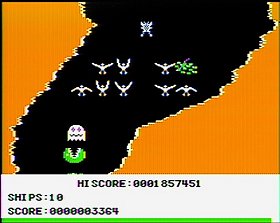 The Game: Why do mountain climbers climb mountains? Because they’re there. Why are you flying a spacecraft into a vast complex of subterranean caverns? Because they’re there, and apparently because you want to blast the multitudes of critters who lurk there. The bad news: there are a lot more of them than there are of you. The good news? Your ship’s cannons fire in four directions simultaneously. Given that fact, and your ship’s maneuverability, you might just survive this little bit of aerial spelunking. (Datamost [designed by Paul Lowrance], 1983)
The Game: Why do mountain climbers climb mountains? Because they’re there. Why are you flying a spacecraft into a vast complex of subterranean caverns? Because they’re there, and apparently because you want to blast the multitudes of critters who lurk there. The bad news: there are a lot more of them than there are of you. The good news? Your ship’s cannons fire in four directions simultaneously. Given that fact, and your ship’s maneuverability, you might just survive this little bit of aerial spelunking. (Datamost [designed by Paul Lowrance], 1983) The Game: You guide the Doctor, that wayward Time Lord, on a quest to retrieve the three segments of the Key to Time, recover your companion from an alien prison, and escape aliens who are on your trail. The game appropriately takes place in four “episodes” (stages). Failing to complete a task will cost you time and a precious regeneration; running out of either one ends the game.
The Game: You guide the Doctor, that wayward Time Lord, on a quest to retrieve the three segments of the Key to Time, recover your companion from an alien prison, and escape aliens who are on your trail. The game appropriately takes place in four “episodes” (stages). Failing to complete a task will cost you time and a precious regeneration; running out of either one ends the game. The Game: How high can you go? Help Jumpman (Mario) save Pauline from Donkey Kong’s clutches by climbing ladders and avoiding barrels. (AtariSoft, 1983)
The Game: How high can you go? Help Jumpman (Mario) save Pauline from Donkey Kong’s clutches by climbing ladders and avoiding barrels. (AtariSoft, 1983)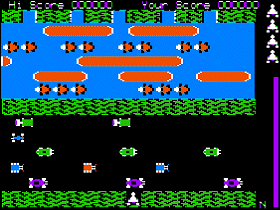 The Game: You are a frog. Your task is simple: hop across a busy highway, dodging cars and trucks, until you get the to the edge of a river, where you must keep yourself from drowning by crossing safely to your grotto at the top of the screen by leaping across the backs of turtles and logs. But watch out for snakes and alligators! (Sierra On-Line, 1983)
The Game: You are a frog. Your task is simple: hop across a busy highway, dodging cars and trucks, until you get the to the edge of a river, where you must keep yourself from drowning by crossing safely to your grotto at the top of the screen by leaping across the backs of turtles and logs. But watch out for snakes and alligators! (Sierra On-Line, 1983)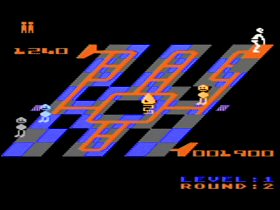 The Game: You’re the circuit maker, and they’re the circuit breakers. You hop around a maze-like structure, dropping circuitry patterns in your wake, as a variety of adversaries try to stop you from completing a circuit leading from the power source at your starting point to the receptacle across the maze from you. Colliding with any of them will cost you a life, but you can entice them to try to chase you off the maze and into oblivion while you escape safely. Completing the circuit advances you to the next maze – just on’t get too caught up in your power trip. (Tronix, 1983)
The Game: You’re the circuit maker, and they’re the circuit breakers. You hop around a maze-like structure, dropping circuitry patterns in your wake, as a variety of adversaries try to stop you from completing a circuit leading from the power source at your starting point to the receptacle across the maze from you. Colliding with any of them will cost you a life, but you can entice them to try to chase you off the maze and into oblivion while you escape safely. Completing the circuit advances you to the next maze – just on’t get too caught up in your power trip. (Tronix, 1983)